
Boris Yeltsin Biography : Russia’s First President
Table of Contents
The History of Boris Yeltsin: Russia’s First President
Boris Yeltsin, born on February 1, 1931, in Sverdlovsk (now Yekaterinburg), was a pivotal figure in Russian history, serving as the first president of Russia from 1991 to 1999. His leadership marked a significant transition from Soviet rule to a new era of democracy and market economy, albeit with considerable challenges and controversies.
Early Life and Political Rise
Yeltsin graduated from the Urals Polytechnic Institute in 1955 and began his career in construction. He quickly rose through the ranks of the Communist Party, becoming the party leader in Sverdlovsk in 1976. His early political career was characterized by reformist tendencies, particularly during his tenure as the first secretary of the Moscow party organization from 1985 to 1987, where he gained a reputation as a determined reformer.
In 1989, Yeltsin was elected to the new Soviet parliament with a landslide victory. His growing discontent with the slow pace of reforms under Mikhail Gorbachev led him to resign from the Communist Party in 1990. By this time, he had become a prominent advocate for greater autonomy for the Russian Republic within the Soviet Union.
Presidency and Major Reforms
Yeltsin was elected president of the Russian Soviet Federative Socialist Republic on June 12, 1991, in the first democratic election in Russian history. His presidency began amid significant political turmoil and economic challenges. He championed radical economic reforms known as “shock therapy,” aimed at transforming Russia’s command economy into a market-oriented system. This included privatization of state assets and lifting price controls.
However, these reforms led to severe economic downturns, hyperinflation, and rising inequality. Many Russians faced deteriorating living conditions as wealth became concentrated among a small group of oligarchs. Despite these challenges, Yeltsin remained committed to his vision of a democratic Russia.
Key Events During Yeltsin’s Presidency
1. Dissolution of the Soviet Union:
On December 25, 1991, following a failed coup against Gorbachev earlier that year and increasing nationalist movements within Soviet republics, Yeltsin played a crucial role in dissolving the Soviet Union. He signed an agreement with leaders from Ukraine and Belarus to create the Commonwealth of Independent States (CIS).
2. Constitutional Crisis:
In September 1993, Yeltsin faced significant opposition from the parliament (Supreme Soviet), which he attempted to dissolve unconstitutionally. This led to a violent standoff in October when Yeltsin ordered military action against the parliament building after armed supporters occupied it. The conflict resulted in numerous casualties but ultimately solidified Yeltsin’s power.
3. New Constitution:
Following the crisis, a new constitution was adopted via referendum in December 1993 that significantly expanded presidential powers, allowing Yeltsin to appoint key government officials and dissolve parliament.
4. Chechen Wars:
Yeltsin’s presidency was marred by conflict in Chechnya. The First Chechen War (1994-1996) began when Chechnya declared independence. The war was marked by significant violence and human rights abuses and contributed to declining public support for Yeltsin.
5. Reelection and Health Issues:
Despite widespread dissatisfaction with his policies and health issues—including heart problems—Yeltsin was reelected in July 1996 against Communist challenger Gennady Zyuganov. His victory was largely attributed to fears of a return to communism.
Resignation and Legacy
On December 31, 1999, Boris Yeltsin unexpectedly announced his resignation, paving the way for his chosen successor, Vladimir Putin. His departure marked the end of an era characterized by tumultuous changes and uncertainty.
Yeltsin’s legacy is complex; he is credited with initiating democratic reforms and transitioning Russia towards a market economy but also criticized for economic hardships, political instability, and corruption that plagued his administration. His presidency laid the groundwork for future developments in Russian politics and society.
Conclusion
Boris Yeltsin remains a controversial figure in Russian history—celebrated by some as a champion of democracy and criticized by others for his handling of economic reforms and political crises. His leadership during a transformative period has left an indelible mark on Russia’s path toward modernization and its ongoing struggles with governance and civil society.
Continue reading: The History of Rameses II: The Great Pharaoh of Ancient Egypt